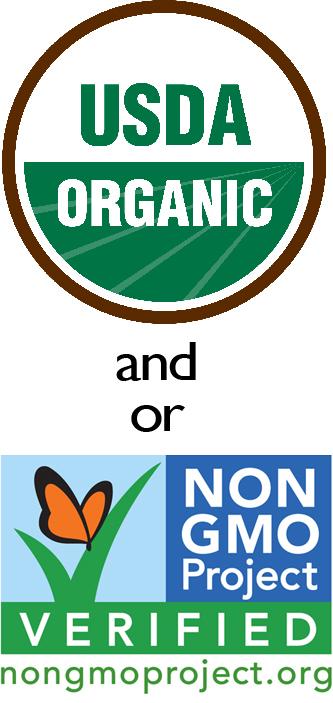By Jane Barthelemy. Our health movement is now mainstream! So what is step #1 for your health? Well, I’d say taking care of the food you eat is pretty high. With so many processed ingredients, one of the easiest things to slip through the cracks is GMO’s! You’re thinking of a chicken salad for lunch? Think again – the chicken will be GMO-fed, and the dressing has GMO canola or soy oil. How about a beef burrito? Nope, the beef is from a CAFO with antibiotics, GMO-feed, and the tortilla is raised with Glyphosate. Okay, so you choose a shrimp wrap. But uh oh! The farmed shrimp is fed GMO grains, and the mayo uses corn oil. So what IS GMO and how can you cut it out of your life? Well, the simple answer is to EAT ORGANIC.
Things you need to know about GMO’s
GMO stands for Genetically Modified Organism – it is the result of a laboratory process where genes from the DNA of one plant or animal are extracted and inserted into the genes of an unrelated organism. Sounds natural and organic right? These foreign genes may come from bacteria, viruses, insects, animals or even humans – lovely. Although traditional crossbreeding has been done by farmers for centuries, GMO foods have only been around since the early 90’s – and were approved with virtually NO testing! In the bigger picture of things 20 years isn’t such a long time, so we’re only beginning to see the unpredicted effects of GMO foods now affect our health – and GMO foods are still found in EVERY food supply. So far, GMO’s are known to destroy intestinal flora, cause auto-immune diseases, food allergies, bloating, obesity, infertility, birth defects, liver atrophy, altered sperm cells. GMO foods also block the natural lymphoma defense systems in the body, increasing the risks of all types of cancer. The list goes on!
The sad truth is that non-GMO foods ARE more expensive, but the price of eating unhealthy food is much greater than those extra couple bucks – yep, think medical bills. And the nutritional value of GMO food is a joke! A recent study comparing GMO corn with non-GMO corn, found vastly lower levels in all the major vitamins and minerals, plus a surprisingly high content of toxic formaldehyde in GMO corn. Is that really worth the price of cutting back on your grocery bill? Think of your clean bill of health as making up the difference in price.
Now that you know what a GMO IS and its affects, how can we avoid buying GMO foods? Well, the easiest way is to buy food labeled 100% organic – in the US and Canada 100% organic food cannot be GMO. That being said, simply seeing “organic” on a package does not mean its not GMO free. Legally, manufacturers can label something “made with organic ingredients, organic” when it contains up to 30% GMO’s. Marketers trying to trick you – surprise surprise. And yes, there are scam labels out there too! Look for products specifically labeled and certified non-GMO or GMO-free.
Think globally act locally! Another way around this is shopping at farmer’s markets! If you can do that, you’re more likely to find non-GMO food. Most GMO food comes from large, industrial farms and is sold nationally. Buy whole foods instead of prepared foods, and cook from scratch. Better yet, grow your own. Enjoy the flavor and higher nutrition in freshly harvested food!
The simplest ways to avoid GMOs are:
1) Buy certified organic / USDA Organic products, which cannot intentionally include any GMO ingredients. Read more about organics and GMOs here >
2) Look for products bearing the “Non-GMO Project” verified seal, which indicate these products went through a separate certification process.
3) Click to visit this list of safe brands, print it, and take it shopping with you.
Learn which foods are most often genetically modified:
- Meat & Poultry – Look for meats that are 100% grass-fed and grass finished. Many cattle are grass-fed, but “finished” with GMO corn, to make the animal gain weight before harvesting, so that the meat is fat and marbled. Ask your butcher for 100% organic or 100% grass-fed or pasture-fed. Most poultry is fed GMO grains. Ask for poultry that is 100% organic, or non-GMO.
- Eggs – Look for eggs labeled 100% organic. You can assume that “free-range”, “natural”, or “cage-free” eggs come from chickens that are fed GMO grains. The best eggs are organic, pasture raised.
- Fish – Your best choice is wild fish. Farmed fish can now be fed cheap GMO grains. If farmed fish is not labeled organic, you can assume it’s fed GMO grain. GMO salmon is now available – avoid it!
- Dairy – Look for milk, cheese, yogurt, and butter that is labeled 100% organic. If it is not, the animals have been fed GMO grains.
- Packaged Food & Baked Goods – You can fairly assume most packaged food contains genetically modified ingredients. Common ones are corn, soy, and beet sugar or their derivatives. A better choice is to avoid the packaged food section. Buy fresh foods and cook from scratch.
- Restaurant Food – Unfortunately, most restaurants buy from large national suppliers that are heavily invested in GMO ingredients which makes eating GMO free a bit tricky – but not impossible. The most common GMO ingredients in restaurants are beet sugar, corn, soy, and canola. If you ask the waiter a specific question about oils and sugar, it can usually be answered by a trip to the kitchen. A restaurant offering organic meat, poultry, dairy and eggs will usually state it on the menu. Otherwise, you can assume they are fed GMO grains. One solution in restaurants is to order vegan, which avoids GMO-fed meat, poultry and eggs.
- Corn – Majority of corn sold in the USA is genetically modified. There are thousands of derivatives of corn to recognize, such as high fructose corn syrup, dextrose, cornstarch, etc. Even local corn can be GMO. Look for 100% organic corn, popcorn, or corn chips.
- Soy – The vast majority of soy sold in the USA is genetically modified. There are thousands of soy derivatives to be aware of, such as tofu, soy milk, soy cheese, vegetable protein, soy sauce. If it’s not labeled 100% organic, then it’s GMO.
- Sugar – Sugar from GMO beets is the most widely consumed GMO food, labeled simply “sugar”. When you see “sugar” on a label, you can’t know for sure if it is GMO or not. However since beet sugar is cheaper than cane sugar, and most manufacturers using “cane sugar” will label it as such, as it is seen as more desirable, when you see “sugar”, assume it is GMO beet sugar.
- Canola Oil – or rapeseed oil, is one of the most common GMO ingredients. Look for 100% organic on the label.
- Zucchini – If it’s not labeled organic is most likely GMO. Fortunately, it is relatively easy to find organic zucchini – or grow it in your garden! It grows as fast as a weed in mine.
- Papaya – Most papaya and ALL Hawaiian papaya is genetically modified. If papaya is not labeled 100% organic, you can assume it is GMO.
- Apples – a recent addition to approved GMO foods. Stick with organic varieties!
- White potatoes – Look for organic, or leave them alone.
Tip: Learn the fruit and vegetable label codes:
- A 5-digit number beginning with a 9 indicates it is organic.
- A 4-digit number indicates the food is conventionally produced, or not organic.
- A 5-digit number beginning with an 8, means it is GMO. However, GMO food may not have a PLU identifying it as such, because PLU labeling is optional.







No Replies to "Avoiding GMO's? Here's a Guide."